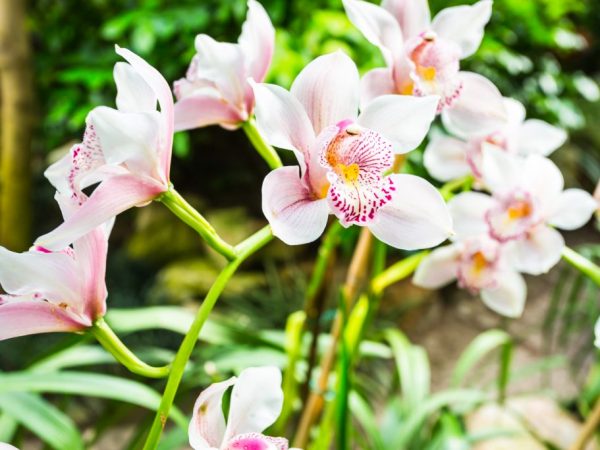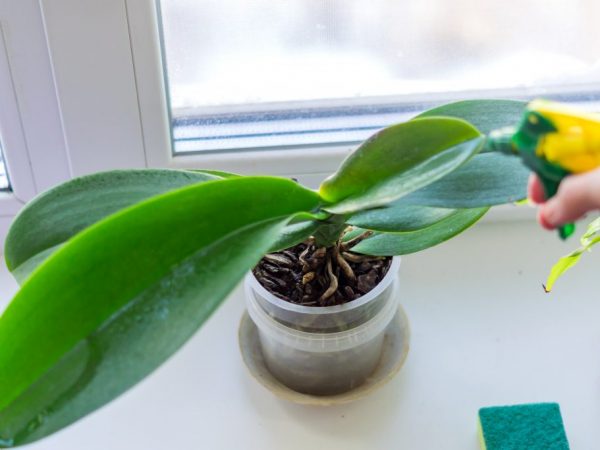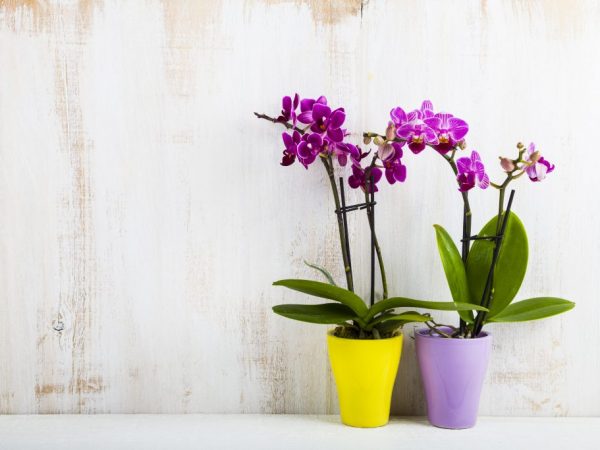Orchid growth types
The type of growth of an orchid is monopodial and sympoidal. Each of them has its own characteristics, the study of which will allow you to properly care for and grow plants.

Orchid growth types
Description of types
Monopodial orchids
Monopodial orchids do not have a rhizome, pseudobulb, the species has 1 vertically growing stem, 1 apical growth point. The apical bud remains throughout the life of the plant, it grows upward, not in width, the leaves are laid at the top, the stem is lengthened.
They begin to develop from the top of the shoot, leaves appear on it in turn. Buds are laid in the axils among the leaves, lateral peduncles or aerial roots grow from them. Over time, aging and dying off of the lower leaves occurs, and a renewed root system develops on the stem.
Monopodial orchids are characterized by the presence of a long, medium or short stem. In phalaenopsis, the stem grows slowly, the leaves are thick and fleshy in appearance, they form faster at the top, and they are collected in a rosette. Leaves (Brassavola, Phalaenopsis) or stems (Vanilla species) of plants without bulbs accumulate moisture and are stored by it.
Sympodial orchids
Sympodial orchids have a large number of shoots (pseudobulbs) growing in a horizontal position, which are united by a rhizome (rhizome). The plant has more than 1 point of growth, development occurs when fresh shoots are formed. Over time, the sprout turns into a pseudobulb.
The sympodial form of growth is characterized by a horizontal direction similar to the vine. In the sympodial orchid, vertical growth signs stop at the end of seasonal growth, fresh lateral growth appears in the new season. The horizontal portions form the rhizome, while the vertical portions appear above the ground.
The sympodial orchid has different pseudobulbs: round and elongated. Pseudobulbs are formed by 1 or more internodes of the stem. After the appearance of leaf-like scales, their growth begins, leaves grow from the scales. After a while, a characteristic type of pseudobulb is formed at their base, in which 2 new buds are laid.
The vital activity of the pseudobulb lasts 2-3 years, after which they turn yellow and die off. After the maturity of the pseudobulb, its apical bud disappears or becomes an inflorescence. After the formation of the peduncle, the pseudobulb does not grow, a new growth is formed at its base and a new development cycle occurs.
In plants, the flower arrow develops from the buds located at the base of the shoot, or in the axils of the leaves, or in its upper part. The sympodial orchid has thin, narrow leaves, and leaf dieback occurs faster than monopodial orchids. This type will bloom if you provide it with a dry and cool dormant period, watering is stopped for 2-2.5 months.Nutrition occurs due to the accumulation of moisture in the pseudobulbs.
Growing

Growing orchids
There are 2 ways of growing at home - traditional and intensive.
Traditional way
There is a clear alternation of periods of growth and rest. The growth period is in summer time. The orchid grows resistant, but development is slow.
Intensive way
Due to the intensive irrigation regime, growth is stimulated. This method is also used on an industrial scale: an increase is obtained by 2 or more times per year. The speed of obtaining flowers from a plant is high, while there is a risk that it will turn out to be weak.
Planting and reproduction of a monopodial orchid
Orchids have long stems, dendrobiums propagate by cuttings of aerial shoots. Cuttings are cut at the top of the stem above the leaf. Within 24 hours, the cuttings are dried, after which they are planted in a dry substrate and placed in a greenhouse. The temperature should be 25 ° C. The roots will appear on the cuttings after 30 days.
Stimulation of the formation of vegetative buds in phalaenopsis occurs by wrapping the sleeping buds with moist sphagnum and polyethylene. A humid and hot development room is suitable.
Planting and reproduction of a sympodial orchid
Sympodial orchids are planted at an angle, laid on a substrate, while a garter is made to a support or a peg. This type of plant can be hung over a pot. When planting, the vegetative mass is placed near the edge of the pot using a support. The rhizome is placed horizontally, this stimulates the growth of the rhizome.
Reproduction occurs after the appearance of nodes with leaves and pseudobulbs. When dividing, the rhizome is divided into sections with nodes.
Each node should consist of 2 pseudobulbs with leaves and tufts of roots. After separation, the plots are planted in different pots. If the plant has taken over after dividing, then new roots and leaves will appear.
Care

The flower needs a lot of attention
First you need to check the condition of all parts of the orchid:
- roots;
- leaves;
- root collar.
If all parts are intact, it should not be repotted.
The flower needs to create favorable conditions:
- correct watering;
- high air humidity;
- lighting;
- transplant if necessary.
Sympodial orchids suffer from dormancy failures. When shoots with bulbs appear during this period, leaves and roots grow in summer, the plant will have problems, it will become weak and will not be able to bloom.
Peduncle care
If the plant has faded, then yellowing and drying of the peduncle occurs. Peduncles of sympodial orchids are removed, in monopodial ones, peduncles are allowed to be left.
Peduncles are cut in the following cases:
- the plant is sick or weak;
- flowering lasted a long time, the process of rest was delayed;
- drying the peduncle.
Diseases and pests
Diseases caused by bacteria, viruses or fungi are dangerous for plants.
Monopoid orchids are often infected with infections that develop in the water around the stem. You can protect the plant by creating favorable conditions.
Diseases caused by fungi arise from high humidity and lack of ventilation. They develop if temperature drops occur.
If a viral disease is affected, the plants will have to be removed.
The growth and development of monopoid and sympoidal orchids is negatively influenced by pests:
- ticks;
- mealybugs;
- thrips;
- scabbards;
- leaf gnats;
- slugs, snails.
Conclusion
The study of monopodial and sympodial orchids allows you to choose and grow the most suitable type of flower. With proper care and cultivation, they will delight with their flowering and active growth.


